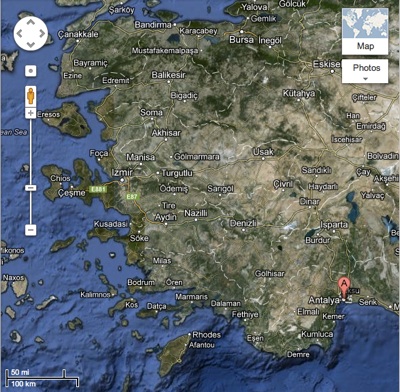North Africa ‘Plus’ Travel Diary

2011
Turkey Tunisia Algeria Iran Transnistria
I realised what a beautiful little village we were staying in when I woke this morning in Şirince. In the morning light, the red-roofed cottages that spilled down the hillside looked idyllic. Although I had been expecting a very quiet night staying in Şirince, it was not to be. The women in the village seemed to enjoy their laughing and happy chatting in the laneway beneath our window until well after midnight, and the all-too-brief overnight calm was shattered just before 5:30 am when the morning call to prayer blasted into our room through the open window from the minaret of the nearby neighbourhood mosque.
Breakfast was served on a terrace of our little inn, and the views across the valley were sensational - as was the breakfast, which comprised a mix of fresh local produce including fruits, tomatoes, various cheeses, breads and preserves. We also had a great time at breakfast talking to a young American couple who had been working in Spain for the past three years and had managed to visit all but a handful of the countries in Europe during that time.
Our first visit of the day was also today’s major sightseeing event - the remains of the ancient city of Ephesus (or as it is known in modern Turkey, Efes). Ephesus is said to be the best preserved old city in the eastern Mediterranean region, and indeed many of the ancient Roman buildings were sufficiently intact that we could get a good idea of everyday life in the days of the Roman Empire.
We reached the south gate of Ephesus at a little before 9 am, hoping to beat the hoards of tourists who famously over-run the ruined city each day, as well as the heat of the day. We didn’t manage to get there before the tourists, or so we thought, until we left a couple of hours later and witnessed the even longer queues waiting to get in at that later hour.
In fact, the crowds of visitors added a lot of life to what might otherwise have been sterile ruins, and they gave an insight into the vibrancy, the animation and the colour of Ephesus as a major city in its heyday.
It is hard to point to particular highlights of Ephesus, as the enjoyment of the experience was taking in the entire ensemble of temples, library, baths, sports fields, amphitheatres, colonnaded avenues, market area, and so on. Having said that, the Library of Celsius, built in the year 114, was a superb centrepiece marking the confluence of the Sacred Way and Curetes Way. Also noteworthy was the huge Great Theatre, an amphitheatre built between 41 AD and 117 AD that was capable of seating 25,000 people where St Paul condemned pagan worship, almost starting a riot as a result. It was in this same amphitheatre that the ‘riot of the silversmiths’ took place after St Paul called on those who made silver images of in which those who made silver figures of the goddess Artemis to cease doing so (Acts:19:23-41).
We spent a great couple of hours exploring Ephesus, but we had to leave a little before 11 am as we had a long drive of 434 kilometres ahead of us to Antalya. Although the first part of the drive was through fairly flat countryside, the landscape soon changed to rolling hills and then some quite spectacular mountain scenery. As if to prove the existence of orographic rainfall, we experienced some unexpectedly torrential rainfall and some electrical thunderstorms as we crossed the elevated hilly areas of central-western Turkey.
We did make one stop on the long drive, which was at Pamukkale, a small town with a unique landform. Pamukkale has a huge area of sparkling white travertine (calcium carbonate) shelves and pools that have been created over the centuries by warm mineral water cooling and depositing calcium carbonate as it cascades over the edge of a cliff. The Romans built a spa city known as Hierapolis there to make use of the water’s curative powers.
In order to get close to the travertines, it is necessary to remove shoes and socks because the walk crosses the calcium deposits with a layer of flowing water over them. The water was warm and immensely therapeutic to walk through - an unexpectedly relaxing experience. Unfortunately, our visit had to be shorter than we had hoped as a major thunderstorm was heading towards us - exposed calcium carbonate hillsides are not great places to be caught in the torrential rain of an electrical thunderstorm.
We reached Antalya at a little after 5 pm, and despite the large size of the city, managed to find our hotel very easily. The long day’s driving from the Aegean Sea to the Mediterranean Sea thus finished with a lovely buffet dinner overlooking the calm, blue waters of beach-fringed Mediterranean Sea.

Day 3 - Selçuk to Antalya, Turkey
Wednesday
15 June 2011
Today’s Bonus Images



















